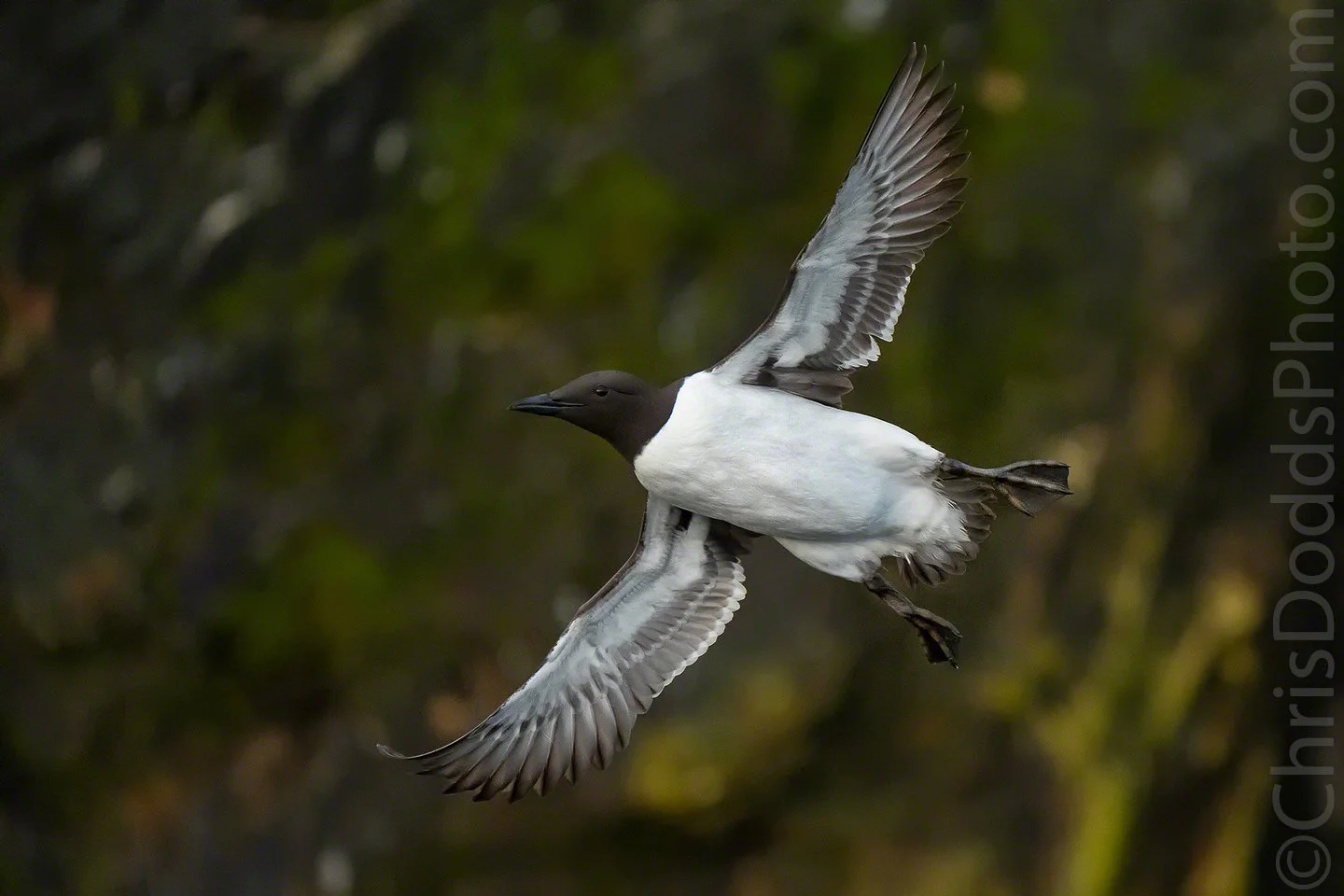Here are a few Common Murre images from my recently concluded Gannets Galore Workshop on Bonaventure Island. The daily Zodiac boat rides(weather permitting) around the cliffs full of seabirds in the early mornings are a highlight of the trip for me. The Sony Alpha 1 paired with the Sony 200-600 proved to be an absolutely perfect combination for the close and fast-moving seabirds like these Common Murres. All of these images were made within a few minutes of each other on the second morning of the first workshop on June 7.
Common Murre in Flight Dorsal View (Uria aalge, Guillemot Marmette, COMU) from my Gannets Galore Workshop on Bonaventure Island, Quebec ©2022 Christopher Dodds All Rights Reserved. Sony 200-600mm @600mm ISO 6,400, f/6.3 @ 1/5,000s Manual exposure. Full frame image.
Common Murre in Flight Ventral View (Uria aalge, Guillemot Marmette, COMU) from my Gannets Galore Workshop on Bonaventure Island, Quebec ©2022 Christopher Dodds All Rights Reserved. Sony 200-600mm @600mm ISO 5,000, f/6.3 @ 1/5,000s Manual exposure. Full frame image.
The Common Murre is found in the seas of the Northern Hemisphere, but unlike the Thick-billed Murre, it prefers ice-free waters. On some islands in the Gulf of St. Lawrence, it nests in dense colonies on narrow cliff ledges, in semi-enclosed rock cavities and in deep fissures, occasionally sharing its quarters with the Razorbill. The Common Murre can fly up to 200 kilometres from the nest to find food for their chicks, and, like the Northern Gannet, they can dive as deep as 100 meters, and depths of 180meters have been recorded. Courtship displays include bowing, billing and preening. The male points its head vertically and makes croaking and growling noises to attract a female. The eggs vary in colour and pattern to help the parents recognize them, each egg is unique. They make no nest and their single egg is incubated on bare rock. The average fledging age is about 21 days, during which the male and female feed the chick with Capelin and sand lance, carrying them one at a time. Both male and female Common Murres moult after breeding and become flightless for 1-2 months. After the breeding season, the Gulf populations move toward the Atlantic and winter off the coasts of Newfoundland. In southern populations, they occasionally return to the nest site throughout the winter. Northern populations spend the winter farther from their colonies. A group of murres are collectively known as a "bazaar" and a "fragrance" of murres (and you should get a whiff of the fragrance under the colony on Bonaventure Island).
In Québec, the Common Murre breeds only in the Gulf of St Lawrence. It is especially abundant on Bonaventure Island, with over 27 000 pairs, and on the Sainte-Marie Islands, where nearly 20 000 pairs nest alongside several other alcid species, including Razorbills and Atlantic Puffins. The Common Murre populations in the Gulf have recovered a great deal during the 70s and 80s but currently, the numbers on the Lower North Shore are still distinctly smaller than those reported by 19th-century naturalists. According to their accounts, an estimated 350 000 pairs of Common Murres bred there at the turn of the century, whereas today there are a mere 20 000. Poaching and human disturbance are the main causes of this decline.
Common Murre(Bridled) in Flight (Uria aalge, Guillemot Marmette - from bridée, COMU) from my Gannets Galore Workshop on Bonaventure Island, Quebec ©2022 Christopher Dodds All Rights Reserved. Sony 200-600mm @600mm ISO 6,400, f/6.3 @ 1/5,000s Manual exposure. Full frame image.
The Common Murre (Bridled) is a race or sub-species of the Common Murre, which is seen in North America. Although the Common Murre is seen in the Pacific and the Atlantic Oceans, this race is only seen in the Atlantic waters. It can be easily recognized by its bold white facial markings. It also has different coloured eggs than the Common Murre. Both races live among each other.
TOP TEN REASONS TO JOIN ME ON BONAVENTURE ISLAND:
I received this in an email from Stan Buman from Carroll, IA way back in 2009:
I joined Chris for the 2009 Gannets Galore Workshop. It was a great learning experience and a wonderful three days. Here are the top ten reasons why I would recommend attending a workshop with Chris.
1. Chris knows the workshop locations and subjects. He has been to the Northern Gannet colony over 375 times, giving him intimate knowledge of the island and bird behavior. All professional wildlife photographers will tell you that knowledge of the subject is crucial for obtaining quality images.
2. With this knowledge, he works hard to put you in the right place by constantly monitoring weather conditions (such as wind direction) and bird activity.
3. Chris is respectful of, and well respected by, the Park Service employees. He treats them well and they treat him well.
4. The Gannets Galore Workshop is more than just photographing on the island. Photography from the Zodiac boat adds a whole new dimension to the diversity of images and bird species.
5. While birds are his primary focus, he is willing to photograph other subjects; Gray Seals come to mind.
6. He is a good birder. It isn’t just all about Gannets.
7. Being a top-notch photographer, Chris knows what it takes to get great images. He is willing to share his knowledge with his participants.
8. I am a better bird photographer because of Chris. Leading by example, he challenged me to work harder on my skills and work outside my comfort zone.
9. For those of you who live to eat, Chris will make sure you are well fed (quality and quantity). I eat to live but think I gained weight on this trip.
10. His ability to speak French comes in handy for us ignorant Americans who never learned to speak anything but English.


